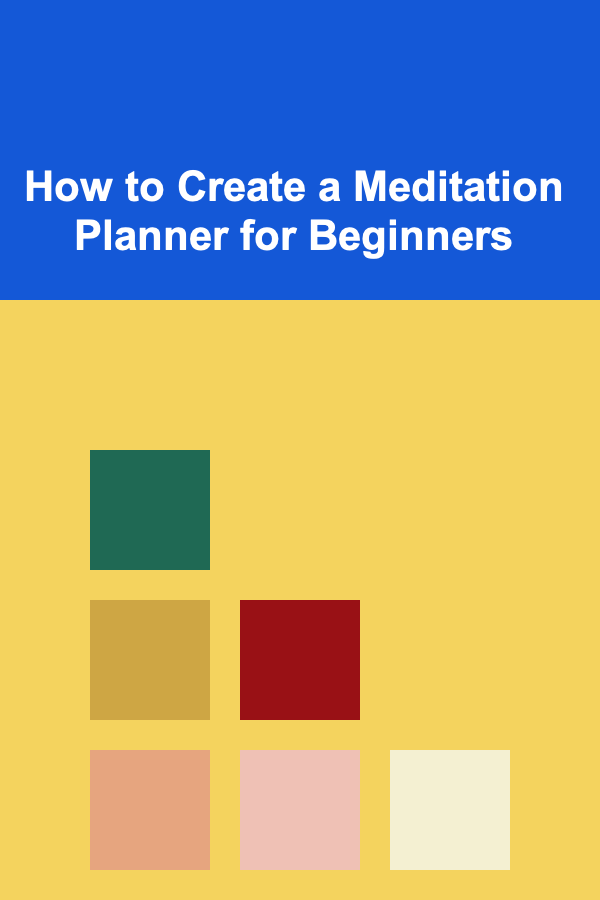
How to Create a Meditation Planner for Beginners
ebook include PDF & Audio bundle (Micro Guide)
$12.99$9.99
Limited Time Offer! Order within the next:

Meditation is a powerful tool for enhancing mental, emotional, and physical well-being. It helps reduce stress, improve focus, increase self-awareness, and promote overall peace of mind. For beginners, starting a meditation practice can be both exciting and overwhelming. The key to creating a successful meditation practice is consistency, and one of the best ways to ensure that consistency is by designing a meditation planner.
A meditation planner helps you track your progress, set achievable goals, and stay motivated throughout your meditation journey. It serves as a guide for beginners to develop a sustainable and fulfilling meditation habit. In this article, we'll explore the steps to create a meditation planner for beginners, the benefits of using one, and tips for staying committed to your practice.
Why You Should Use a Meditation Planner
Before diving into the specifics of creating a meditation planner, it's important to understand the benefits of using one. Here's why a meditation planner can make a difference:
1. Consistency
A meditation planner encourages you to meditate regularly. It serves as a reminder to carve out time each day for your practice, which is key to seeing results. Consistency is the foundation of any successful meditation routine.
2. Track Progress
As you move forward in your meditation journey, it can be easy to forget how far you've come. A planner allows you to track your sessions, reflect on your experiences, and measure improvements. This progress tracking helps you celebrate small wins and stay motivated.
3. Set and Achieve Goals
A meditation planner allows you to set both short-term and long-term meditation goals. This could include goals such as meditating for a certain number of minutes each day or achieving a deeper state of relaxation. Setting specific goals ensures that your practice evolves and improves over time.
4. Increase Accountability
If you're prone to skipping your practice, a planner can help hold you accountable. Writing down your daily meditation sessions and reflecting on your experiences makes you more likely to stick with the habit.
5. Enhance Mindfulness
A meditation planner not only tracks your practice but also helps you become more mindful of your emotions, thoughts, and sensations. By recording your reflections after each session, you'll develop a deeper understanding of your inner world.
Steps to Create a Meditation Planner for Beginners
Now that we understand why a meditation planner is valuable, let's dive into the steps of creating one. A well-structured meditation planner for beginners should focus on simplicity and flexibility. It should encourage you to explore different meditation techniques and track your progress without overwhelming you. Here's how to create your own:
1. Choose the Format of Your Planner
The first step in creating a meditation planner is deciding on the format. Do you prefer a physical journal, a digital app, or an online spreadsheet? Consider your personal preferences, and choose the format that you're most likely to stick with.
- Physical Journal: A traditional notebook or journal is a great option for those who prefer writing by hand. It also allows for creativity in designing the layout and adding personal touches.
- Digital Planner: Many apps are available for meditation tracking, such as Insight Timer, Headspace, or Calm. These apps allow you to track your meditation sessions, access guided meditations, and reflect on your practice.
- Spreadsheet: For a more structured approach, you can create a meditation planner using a spreadsheet tool like Google Sheets or Excel. This option provides flexibility to track your sessions and progress in a detailed manner.
2. Create a Simple Daily Meditation Log
A simple daily log is an essential feature of any meditation planner. This log will help you track the duration of each meditation session, the technique used, and any insights or feelings experienced.
Here's what you can include in your daily meditation log:
- Date: Record the date of each session.
- Meditation Duration: Write down the number of minutes you meditated.
- Technique Used: Note the meditation technique you practiced (e.g., mindfulness meditation, loving-kindness meditation, body scan, etc.).
- How You Felt: Write a brief reflection on how you felt before and after the session. Did you feel more relaxed, focused, or energized? Were there any challenges during the practice?
- Insights: Record any thoughts, feelings, or realizations that arose during the meditation.
By keeping track of these aspects, you'll have a clear picture of your meditation habits and the emotional shifts that come with regular practice.
3. Set Weekly or Monthly Goals
Setting goals for your meditation practice will keep you motivated and provide a sense of direction. Goals can range from simple daily objectives to more complex weekly or monthly targets. Be realistic and start small. As a beginner, the aim is to build consistency rather than perfection.
Here are some examples of goals for beginners:
- Daily Meditation Goal: Aim to meditate for 5-10 minutes each day. Once you've mastered this, gradually increase the duration.
- Technique Exploration Goal: Commit to trying different meditation techniques each week to find what works best for you.
- Mindfulness Integration Goal: Incorporate mindfulness practices into your daily life, such as mindful eating or mindful walking.
You can track these goals by creating a checklist or a separate section in your planner for each goal.
4. Include Reflections and Insights
Meditation is not just about the act of sitting still; it's also about self-discovery. One of the most valuable aspects of meditation is the insights you gain into your thoughts, emotions, and behavior. Your planner should provide space for you to reflect on these insights.
- Daily Reflection: After each session, jot down any thoughts, feelings, or realizations that came up. This can help you better understand your meditation practice and track patterns over time.
- Weekly Reflection: Once a week, take some time to review your progress. What meditation techniques did you enjoy the most? What challenges did you face? Have you noticed any improvements in your mood, focus, or stress levels?
The act of writing down your reflections will deepen your mindfulness and awareness of your personal growth.
5. Include Inspirational Quotes or Affirmations
To keep you motivated, consider adding inspirational quotes or affirmations to your planner. These can serve as gentle reminders of the benefits of meditation and help you stay positive during challenging days. Choose quotes that resonate with your values or intentions for your meditation practice.
Here are some examples:
- "Meditation is not about stopping thoughts, but about not letting them control you." -- Anonymous
- "In the process of letting go, you'll gain more than you could ever imagine." -- Anonymous
- "I am at peace with myself and the world around me."
6. Design the Planner to Fit Your Schedule
It's important to create a meditation planner that aligns with your lifestyle and schedule. As a beginner, you might not have the time for long meditation sessions, so keep your goals flexible.
- Morning or Evening Sessions: Decide if you prefer meditating in the morning to start your day with clarity or in the evening to wind down. You could also choose to meditate at different times depending on your energy levels.
- Time Commitments: If you're pressed for time, start with shorter sessions (e.g., 5-10 minutes) and gradually increase the duration as you become more comfortable.
- Track Other Habits: If you want to integrate meditation with other habits, such as exercise or journaling, leave space in your planner to track these activities as well.
The goal is to make meditation a natural part of your day without it feeling like a burden.
7. Stay Flexible and Adjust When Needed
Your meditation practice will evolve over time, and your planner should be adaptable to your changing needs. If you find that certain techniques or goals are no longer serving you, feel free to adjust them. The planner is a tool to support your growth, not a rigid structure to follow.
As you continue to meditate, you may discover new techniques, develop a deeper sense of mindfulness, or experience different challenges. Use your planner to reflect on these changes and continue to evolve your practice.
Tips for Staying Committed to Your Meditation Practice
Creating a meditation planner is just one part of the equation. The key to success lies in maintaining your commitment to the practice. Here are some tips for staying on track:
1. Start Small
It's better to start with shorter sessions and gradually increase the time as you become more comfortable. Starting small prevents overwhelm and sets you up for success.
2. Make Meditation a Routine
Consistency is key. Schedule your meditation sessions at the same time each day, whether it's in the morning, during lunch, or before bed. This helps establish meditation as a daily habit.
3. Join a Community
If you find it difficult to meditate alone, consider joining a meditation group or community. This could be an online group or a local meditation center. Sharing your journey with others can keep you motivated and provide support.
4. Be Compassionate with Yourself
Meditation is a practice, not a perfection. There will be days when you struggle to focus or miss a session. Don't be too hard on yourself---acknowledge the challenges and continue forward with a compassionate mindset.
Conclusion
Creating a meditation planner for beginners is a powerful way to track your progress, stay motivated, and build a consistent meditation practice. By setting realistic goals, reflecting on your experiences, and adjusting your plan as needed, you'll develop a deeper connection to your meditation practice and enjoy its many benefits.
Remember, meditation is a journey, not a destination. With patience, consistency, and the right tools---like a meditation planner---you can cultivate mindfulness, peace, and clarity in your daily life.

How to Avoid Common Mistakes in Property Investment
Read More
How to Create a Kid-Friendly Homework Station
Read More
How to Improve Inventory Visibility with Real-Time Data
Read More
How to Plan a Succession Planting Schedule
Read More
10 Tips for Writing Thank You Cards That Truly Resonate
Read More
10 Tips for Optimizing Traffic Flow in Urban Areas
Read MoreOther Products

How to Avoid Common Mistakes in Property Investment
Read More
How to Create a Kid-Friendly Homework Station
Read More
How to Improve Inventory Visibility with Real-Time Data
Read More
How to Plan a Succession Planting Schedule
Read More
10 Tips for Writing Thank You Cards That Truly Resonate
Read More